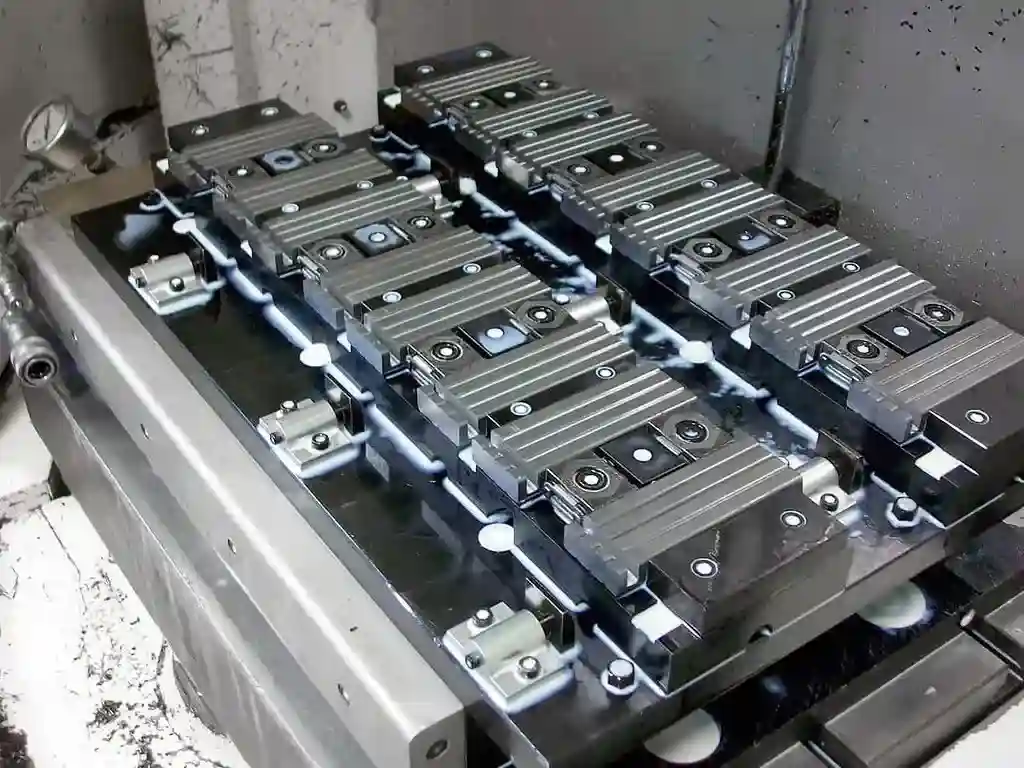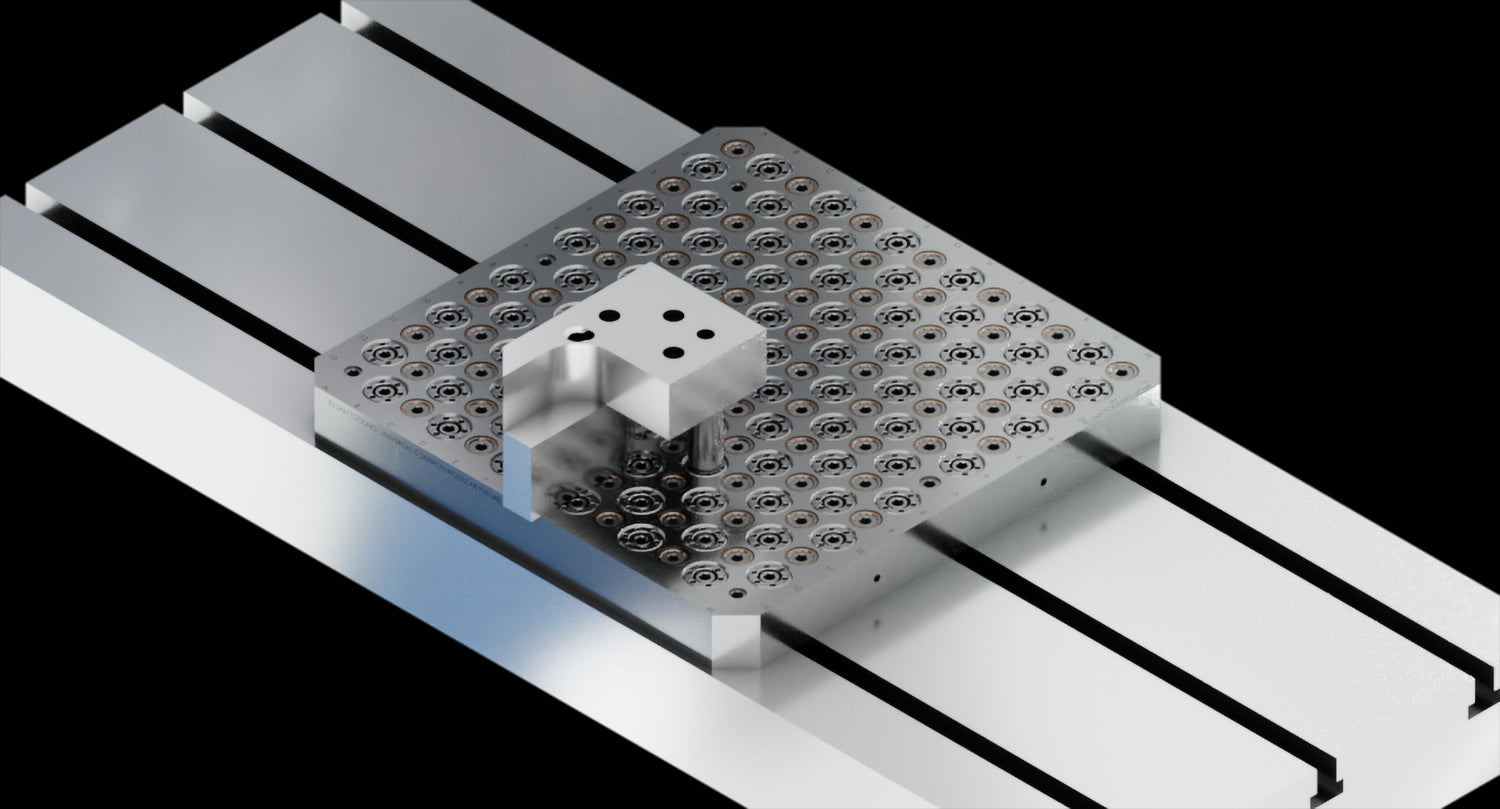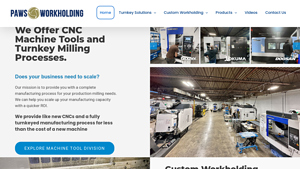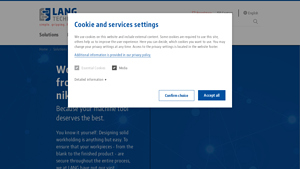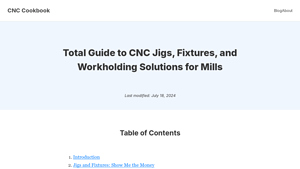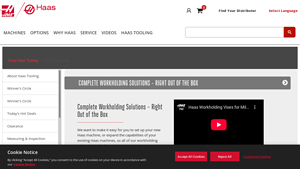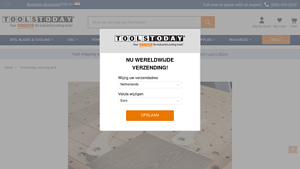Cnc Workholding Guide: Type, Cost, Top List…
Introduction: Navigating the Global Market for cnc workholding
In today’s competitive manufacturing landscape, sourcing effective CNC workholding solutions can be a daunting challenge for international B2B buyers. Achieving precision, stability, and efficiency in machining operations is critical, yet many buyers struggle to identify the right products that meet their specific requirements. This comprehensive guide will delve into the various types of CNC workholding devices, their applications across different industries, and essential factors for supplier vetting.
From vises and clamps to advanced modular systems, understanding the full spectrum of workholding options is crucial for optimizing production processes. Additionally, we will provide insights into cost considerations, helping you to balance quality with budget constraints. By equipping yourself with knowledge about the latest technologies and best practices, you will be empowered to make informed purchasing decisions that enhance your operational efficiency.
This guide specifically caters to international buyers from regions such as Africa, South America, the Middle East, and Europe, including key markets like Brazil and Germany. By navigating the complexities of CNC workholding through this resource, you can confidently select the right solutions that not only meet your machining needs but also drive your business forward in the global market.
Understanding cnc workholding Types and Variations
| Type Name | Key Distinguishing Features | Primary B2B Applications | Brief Pros & Cons for Buyers |
|---|---|---|---|
| Vises | Fixed or adjustable jaws for secure gripping | Precision machining, milling | Pros: High stability; Cons: Limited flexibility. |
| Clamps | Versatile devices for holding various shapes | General machining, assembly | Pros: Quick setup; Cons: May require multiple types. |
| Fixtures | Custom-made devices for specific parts | High-volume production, complex shapes | Pros: Enhanced efficiency; Cons: Higher initial cost. |
| Vacuum Workholding | Uses suction to hold flat or irregular shapes | Woodworking, plastic machining | Pros: Minimal surface damage; Cons: Requires air supply. |
| Modular Systems | Configurable systems for diverse applications | Rapid prototyping, small batch runs | Pros: Flexible; Cons: Complexity in setup. |
What Are the Key Characteristics of Vises in CNC Workholding?
Vises are fundamental components in CNC workholding, characterized by fixed or adjustable jaws that securely grip the workpiece. They are essential in precision machining and milling applications, providing high stability during operations. When considering a vise, buyers should assess the size, jaw configuration, and clamping force to ensure compatibility with their CNC machinery. While vises offer excellent rigidity, they may lack the flexibility needed for varied workpiece shapes.
How Do Clamps Enhance CNC Workholding Flexibility?
Clamps are versatile devices that can hold a variety of shapes and sizes, making them ideal for general machining and assembly tasks. They can be quickly set up and adjusted, which is advantageous for operations that require frequent changes in workpieces. Buyers should consider the specific clamp types needed for their applications, as different designs cater to various holding requirements. However, using multiple clamps may be necessary to accommodate diverse shapes, which can complicate the setup process.
Why Are Fixtures Essential for High-Volume Production?
Fixtures are custom-made devices designed to hold specific parts securely during machining. They are particularly beneficial in high-volume production environments where efficiency is critical. By reducing setup times and improving part repeatability, fixtures can significantly enhance production rates. However, buyers should weigh the initial investment against the long-term efficiency gains, as custom fixtures can be costly to design and manufacture. Understanding the production volume and complexity of parts is vital when deciding on fixtures.
What Advantages Do Vacuum Workholding Systems Offer?
Vacuum workholding systems utilize suction to hold workpieces, making them suitable for flat or irregular shapes, especially in woodworking and plastic machining. These systems minimize surface damage, which is crucial for delicate materials. When considering vacuum workholding, buyers should evaluate the required air supply and the compatibility of the vacuum system with their existing CNC equipment. While effective, the need for an air supply can limit the system’s application in some environments.
How Do Modular Workholding Systems Improve Efficiency?
Modular workholding systems consist of configurable components that allow for rapid adjustments and setups for diverse machining applications. They are especially useful in rapid prototyping and small batch runs, where flexibility is essential. Buyers should focus on the compatibility of modular components with their existing systems and the ease of assembly. Although they offer significant flexibility, the complexity of setup may deter some users, requiring a learning curve for optimal use.
Key Industrial Applications of cnc workholding
| Industry/Sector | Specific Application of CNC Workholding | Value/Benefit for the Business | Key Sourcing Considerations for this Application |
|---|---|---|---|
| Aerospace | Precision component manufacturing | Enhanced accuracy and reduced waste | Need for high-tolerance fixtures and lightweight materials |
| Automotive | Engine block machining | Improved cycle times and consistent quality | Robust clamping solutions for heavy components |
| Medical Devices | Custom surgical instrument fabrication | High precision and compliance with regulatory standards | Biocompatible materials and precise fixturing options |
| Electronics | PCB and component assembly | Streamlined production and reduced handling errors | Modular workholding for flexibility and quick setup |
| Oil & Gas | Drilling equipment part production | Increased efficiency and safety in harsh environments | Durable and corrosion-resistant materials |
How is CNC Workholding Applied in Aerospace Manufacturing?
In the aerospace industry, CNC workholding is crucial for the precision machining of components like turbine blades and fuselage parts. These components require extremely tight tolerances due to the safety and performance demands of aviation. Using specialized fixtures, manufacturers can secure parts firmly, minimizing vibrations and ensuring consistent machining results. International buyers should consider sourcing lightweight yet durable materials, as well as solutions that meet stringent aerospace standards.
What Role Does CNC Workholding Play in Automotive Engine Block Machining?
For automotive manufacturing, particularly in engine block machining, CNC workholding solutions significantly enhance productivity and quality. Fixtures designed for heavy engine components allow for secure clamping, enabling high-speed cutting with minimal deflection. This results in improved cycle times and consistent part quality. Buyers from regions with a strong automotive presence, like Germany and Brazil, should prioritize robust clamping mechanisms that can handle the weight and complexity of engine components.
How is CNC Workholding Used in Medical Device Manufacturing?
In the medical devices sector, CNC workholding is essential for producing custom surgical instruments with high precision. Fixtures must accommodate complex geometries while ensuring compliance with strict regulatory standards. The ability to maintain tight tolerances is vital, as even minor deviations can affect device performance. Buyers in this sector should focus on sourcing biocompatible materials and workholding solutions that offer precise alignment and repeatability for consistent results.
What are the Benefits of CNC Workholding in Electronics Assembly?
CNC workholding plays a pivotal role in the electronics industry, particularly in the assembly of printed circuit boards (PCBs) and components. Effective workholding systems streamline production processes, reducing handling errors and improving overall efficiency. Modular workholding solutions allow for quick setup changes, accommodating various component sizes and designs. International buyers should seek out flexible and easily adjustable clamping systems to enhance their production capabilities.
How Does CNC Workholding Enhance Production in the Oil & Gas Sector?
In the oil and gas industry, CNC workholding solutions are employed to manufacture parts for drilling equipment and pipelines. These applications demand high efficiency and safety, especially in challenging environments. Workholding systems that are durable and resistant to corrosion are essential to ensure long-lasting performance. Buyers should consider sourcing heavy-duty workholding solutions that can withstand the rigors of oil and gas operations while maintaining precise machining capabilities.
3 Common User Pain Points for ‘cnc workholding’ & Their Solutions
Scenario 1: Struggles with Part Stability During Machining Operations
The Problem: B2B buyers frequently encounter issues related to the stability of workpieces during machining. Inconsistent clamping can lead to vibrations, misalignments, or even part damage, resulting in costly rework and extended lead times. This instability is particularly problematic when working with intricate designs or materials that require high precision, as any deviation can impact the final product’s quality and the company’s reputation.
The Solution: To address these stability challenges, it is crucial to invest in high-quality workholding solutions designed specifically for the parts being machined. Consider using vises that offer superior clamping force and minimal jaw deflection. Implementing modular fixturing systems can also enhance stability, allowing for custom setups tailored to specific parts. Additionally, ensure that the workholding devices are compatible with your CNC machine’s T-slots for secure attachment. Regularly assess and calibrate the workholding equipment to maintain optimal performance and prevent issues before they arise. For complex geometries, consider utilizing specialized fixtures or custom jigs that hold the part securely from multiple angles.
Scenario 2: Inefficiencies in Setup Times Leading to Increased Costs
The Problem: Many B2B buyers face the challenge of long setup times when transitioning between different machining tasks. This not only disrupts production schedules but also inflates operational costs. In high-competition markets, the ability to quickly switch setups can be the difference between meeting deadlines and losing business opportunities.
The Solution: To combat inefficiencies in setup times, implementing a modular workholding system can be transformative. These systems allow for quick changeovers by using pre-made fixture plates that can easily be swapped out without extensive recalibration. Buyers should also look into automated solutions like pallet changers, which enable simultaneous loading and unloading of workpieces. Training staff on efficient setup practices and maintaining an organized workspace can further reduce downtime. Conducting a thorough analysis of current setup procedures can help identify bottlenecks and allow for targeted improvements, ultimately reducing setup time and increasing overall productivity.
Scenario 3: Difficulty in Selecting the Right Workholding Solutions for Diverse Applications
The Problem: B2B buyers often struggle to select the appropriate workholding solutions for their specific machining applications, particularly when dealing with a diverse range of parts and materials. This challenge can lead to underutilization of machines and suboptimal production processes, as the wrong workholding device may not provide adequate support or precision.
The Solution: To effectively choose the right workholding solution, buyers should conduct a comprehensive analysis of their machining needs. This includes evaluating the size, shape, and material of the parts being processed. Engaging with suppliers who offer a diverse array of workholding solutions can provide valuable insights and recommendations tailored to specific applications. It is also beneficial to leverage technology such as CAD software to simulate workholding setups before implementation. Participating in industry forums or workshops can further enhance knowledge about the latest trends and innovations in workholding technology. By investing time in proper evaluation and consultation, buyers can optimize their machining processes and achieve better results.
Strategic Material Selection Guide for cnc workholding
What Are the Key Properties of Common Materials Used in CNC Workholding?
When selecting materials for CNC workholding solutions, it’s crucial to consider properties such as strength, thermal stability, and corrosion resistance. Here, we analyze four common materials: aluminum, steel, cast iron, and polymer composites, focusing on their performance, advantages, disadvantages, and specific considerations for international buyers.
How Does Aluminum Perform in CNC Workholding Applications?
Aluminum is a lightweight metal known for its excellent strength-to-weight ratio and corrosion resistance. It typically performs well under moderate temperatures and pressures, making it suitable for various CNC applications. The primary advantages of aluminum include its ease of machining and lower cost compared to other metals. However, it may not withstand extreme conditions as effectively as steel or cast iron. For international buyers, aluminum’s compliance with standards such as ASTM and DIN can facilitate smoother procurement processes, especially in regions like Europe and South America where these standards are prevalent.
What Are the Advantages and Limitations of Steel in CNC Workholding?
Steel, particularly tool steel, is renowned for its durability and high tensile strength, making it ideal for heavy-duty workholding applications. It has a higher temperature and pressure rating than aluminum, allowing it to perform well in demanding environments. However, steel can be heavier and more expensive, which may increase shipping costs for international buyers. Additionally, it is susceptible to corrosion unless treated, which is a critical consideration in humid climates like those found in parts of Africa and the Middle East. Compliance with international standards such as ASTM and JIS is also vital for ensuring product quality and safety.
How Does Cast Iron Compare to Other Materials for CNC Workholding?
Cast iron is favored for its excellent vibration dampening properties and stability under load, making it suitable for precision machining. It offers high rigidity and is less likely to deform during machining processes, which is crucial for maintaining part accuracy. However, cast iron is relatively brittle and can be more challenging to machine than aluminum or steel. Its weight can also pose logistical challenges for international shipping. Buyers from Europe and South America should consider the specific grades of cast iron that comply with local standards to ensure compatibility with their machining processes.
What Role Do Polymer Composites Play in CNC Workholding Solutions?
Polymer composites, such as nylon or fiberglass-reinforced plastics, are increasingly used in CNC workholding due to their lightweight nature and resistance to corrosion. These materials can withstand moderate pressures and temperatures, making them suitable for less demanding applications. The primary advantage of polymer composites is their cost-effectiveness and ease of customization. However, they may not provide the same level of strength and durability as metals, limiting their use in heavy-duty applications. For international buyers, understanding the specific chemical compatibility of polymer composites with the media they will encounter is essential, particularly in industries like aerospace and automotive.
Summary of Material Selection for CNC Workholding
| Material | Typical Use Case for cnc workholding | Key Advantage | Key Disadvantage/Limitation | Relative Cost (Low/Med/High) |
|---|---|---|---|---|
| Aluminum | Lightweight fixtures and clamps | Excellent strength-to-weight ratio | Limited performance under extreme conditions | Low |
| Steel | Heavy-duty vises and fixtures | High durability and tensile strength | Heavier and more expensive | Medium |
| Cast Iron | Precision machining bases | Excellent vibration dampening | Brittle and challenging to machine | Medium |
| Polymer Composites | Lightweight, custom fixtures | Cost-effective and easy to customize | Lower strength and durability than metals | Low |
This strategic material selection guide provides international B2B buyers with insights into the properties, advantages, and limitations of various materials used in CNC workholding. By understanding these factors, buyers can make informed decisions that align with their specific operational needs and compliance requirements.
In-depth Look: Manufacturing Processes and Quality Assurance for cnc workholding
What Are the Main Stages in the Manufacturing Process of CNC Workholding?
The manufacturing process for CNC workholding involves several crucial stages that ensure the final product meets the precision and durability required in industrial applications. These stages include material preparation, forming, assembly, and finishing.
Material Preparation
The first stage involves selecting the appropriate materials, typically high-grade metals like aluminum or steel, known for their strength and resistance to wear. Material preparation includes cutting the raw materials to size, followed by machining processes such as milling or turning to create initial shapes. Advanced techniques like laser cutting may also be employed for precision. At this stage, it is critical to assess material quality through visual inspections and mechanical testing to ensure compliance with specifications.
Forming Techniques
Once the materials are prepared, the next step is forming, which involves shaping the components into their final configurations. This can include processes such as CNC machining, where precise dimensions are achieved using computer-controlled machines. Other methods may include bending, stamping, or forging, depending on the design requirements. Each method has its advantages and can influence the strength, weight, and overall performance of the workholding device. For instance, CNC machining offers unparalleled accuracy, making it a preferred choice for high-precision applications.
Assembly Process
The assembly stage integrates various components to create the final product. This may involve the installation of screws, clamps, or fixtures that hold the workpiece securely during machining. Modular designs are becoming increasingly popular, allowing for quick adjustments and the ability to adapt to different workpieces. During assembly, it is essential to follow strict protocols to ensure that all parts fit together correctly, which contributes to the overall rigidity and stability of the workholding system.
Finishing Techniques
Finishing is the final stage of the manufacturing process, aimed at enhancing the surface quality and protecting against corrosion. Techniques such as anodizing, powder coating, or painting are commonly used to improve durability and aesthetics. This stage may also include additional machining processes to achieve a smooth finish or specific tolerances. Proper finishing not only extends the life of the workholding devices but also enhances their performance by reducing friction and wear during operation.
How Is Quality Assurance Implemented in CNC Workholding Manufacturing?
Quality assurance (QA) in CNC workholding is integral to ensuring that products meet international standards and customer expectations. Effective QA processes typically encompass several checkpoints and testing methodologies, which include incoming quality control (IQC), in-process quality control (IPQC), and final quality control (FQC).
International Standards and Certifications
To maintain high-quality production, manufacturers often adhere to international standards such as ISO 9001, which outlines requirements for a quality management system. Compliance with standards like CE and API is also crucial, especially for companies exporting to regions like Europe or the Middle East. These certifications indicate that products have undergone rigorous testing and meet safety and performance standards.
Quality Control Checkpoints
-
Incoming Quality Control (IQC): This initial checkpoint focuses on raw materials and components received from suppliers. IQC processes include visual inspections, dimensional checks, and material property tests to ensure all incoming materials meet specified requirements.
-
In-Process Quality Control (IPQC): During the manufacturing process, IPQC monitors production techniques and outputs. This may involve regular sampling and testing of parts at various stages, utilizing tools like calipers and gauges to verify dimensions and tolerances.
-
Final Quality Control (FQC): At this stage, the completed workholding devices undergo comprehensive inspections to ensure they meet all specifications and standards. This can include functional testing, stress tests, and verification of surface finishes. FQC is crucial for identifying any defects that may have occurred during manufacturing.
What Testing Methods Are Commonly Used for CNC Workholding Quality Assurance?
Various testing methods are employed to ensure the quality of CNC workholding devices. Common techniques include:
-
Dimensional Inspection: Utilizing precision measurement tools to confirm that components conform to specified dimensions and tolerances.
-
Functional Testing: Assessing the performance of workholding devices under simulated operational conditions to ensure they can securely hold workpieces during machining.
-
Material Testing: Conducting tests such as tensile strength, hardness, and impact resistance to verify the material properties of the components used.
-
Surface Finish Measurement: Using profilometers to measure the roughness of surfaces, ensuring they meet the required standards for friction and wear.
How Can B2B Buyers Verify Supplier Quality Control Processes?
B2B buyers must ensure that their suppliers adhere to rigorous quality control processes. Here are several ways to verify supplier QC:
-
Audits and Inspections: Conducting on-site audits of the manufacturing facilities can provide insights into the supplier’s quality control practices. Buyers can assess equipment, processes, and overall compliance with standards.
-
Quality Reports: Requesting documentation that outlines the supplier’s quality control procedures, including results from testing and inspections, can help buyers evaluate their commitment to quality.
-
Third-Party Inspections: Engaging third-party inspection services can offer unbiased assessments of the supplier’s products and processes. This is particularly beneficial when dealing with international suppliers.
What Are the QC and Certification Nuances for International B2B Buyers?
International buyers, particularly those from Africa, South America, the Middle East, and Europe, should be aware of specific nuances when it comes to quality control and certifications. For instance, different regions may have varying regulatory requirements for product certifications. Understanding these requirements is crucial for ensuring compliance and avoiding costly delays in customs.
Additionally, language barriers and cultural differences can impact communication regarding quality standards. Buyers should establish clear lines of communication and consider using local representatives or consultants to facilitate discussions with suppliers.
In conclusion, a thorough understanding of the manufacturing processes and quality assurance protocols for CNC workholding devices is vital for B2B buyers. By focusing on these aspects, businesses can make informed decisions, ensuring they partner with suppliers who prioritize quality and reliability in their production processes.
Practical Sourcing Guide: A Step-by-Step Checklist for ‘cnc workholding’
Introduction
This practical sourcing guide is designed to assist B2B buyers in procuring CNC workholding solutions effectively. Whether you are based in Africa, South America, the Middle East, or Europe, understanding the key steps in the sourcing process can help you select the right equipment that meets your operational requirements while optimizing cost and efficiency.
Step 1: Define Your Technical Specifications
Clearly outline the specifications required for your CNC workholding solutions. This includes understanding the type of materials you will be working with, the dimensions of your workpieces, and the specific machining processes involved.
– Key Considerations:
– Material compatibility: Ensure the workholding is suitable for the materials you use.
– Size and weight: Consider the maximum dimensions and weight of the workpieces to ensure stability.
Step 2: Assess Your Production Needs
Evaluate your production volume and the complexity of the parts you will be machining. This will help determine whether you need standard workholding solutions or custom fixtures.
– Volume Requirements:
– For high-volume production, investing in custom fixtures may reduce cycle times.
– For low-volume or prototyping, standard solutions might suffice.
Step 3: Evaluate Potential Suppliers
Conduct thorough research on potential suppliers to gauge their reliability and product quality. Request company profiles, case studies, and references from buyers in similar industries.
– Supplier Verification:
– Look for industry certifications that demonstrate compliance with international standards.
– Analyze customer reviews and case studies to understand the supplier’s performance and service levels.
Step 4: Request Samples and Demonstrations
Before making a final decision, request samples or demonstrations of the workholding solutions. This allows you to assess the quality and suitability of the products in your operational context.
– Testing Focus:
– Evaluate the ease of setup and operation.
– Ensure the clamping force and stability meet your machining requirements.
Step 5: Analyze Cost vs. Value
Consider the overall cost of the workholding solutions in relation to their expected value. This includes upfront costs, maintenance, and potential savings in production time.
– Cost Considerations:
– Compare the total cost of ownership (TCO) for different suppliers.
– Factor in long-term benefits, such as reduced setup times and enhanced machining accuracy.
Step 6: Check After-Sales Support and Warranty
Investigate the level of after-sales support offered by the supplier, including warranty terms and technical assistance. Reliable support can significantly impact your operational efficiency.
– Support Aspects:
– Ensure the availability of spare parts and technical support when needed.
– Understand the warranty terms to safeguard your investment.
Step 7: Finalize the Purchase Agreement
Once you have assessed all options and are confident in your choice, finalize the purchase agreement. Ensure that all specifications, delivery timelines, and payment terms are clearly outlined.
– Contract Clarity:
– Review all terms to avoid hidden costs or misunderstandings.
– Ensure that you have a clear return policy in case the product does not meet your expectations.
By following this checklist, B2B buyers can navigate the complexities of sourcing CNC workholding solutions more effectively, ensuring that their investment aligns with their operational goals and requirements.
Comprehensive Cost and Pricing Analysis for cnc workholding Sourcing
What Are the Key Cost Components in CNC Workholding?
When sourcing CNC workholding solutions, understanding the cost structure is essential for B2B buyers. The primary cost components include:
-
Materials: The choice of materials significantly affects pricing. High-strength alloys and specialized plastics may increase costs but enhance durability and performance. For instance, aluminum is often used for lightweight fixtures, while steel is preferred for high-stress applications.
-
Labor: Labor costs can vary based on the complexity of the workholding design and the skill level required. Custom solutions may demand specialized labor, impacting overall pricing.
-
Manufacturing Overhead: This includes indirect costs such as utilities, rent, and administrative expenses associated with running the manufacturing facility. A well-optimized manufacturing process can help lower these overheads.
-
Tooling: The investment in tooling, including jigs and fixtures, is critical. Custom tooling can drive up initial costs but may lead to significant savings in production time and material waste.
-
Quality Control (QC): Ensuring that workholding products meet quality standards can incur additional costs. Certifications such as ISO or CE may also influence the price, as suppliers often pass these costs onto the buyer.
-
Logistics: Transportation and shipping costs can vary widely based on distance and the mode of transport. International buyers should consider these costs when evaluating total expenses.
-
Margin: Suppliers will typically mark up prices to ensure profitability. This margin can vary significantly based on competition, demand, and supplier reputation.
What Influences Pricing for CNC Workholding Products?
Several factors can influence the pricing of CNC workholding solutions:
-
Volume and Minimum Order Quantity (MOQ): Bulk purchases often lead to lower per-unit costs. Establishing long-term relationships with suppliers may also result in better pricing.
-
Specifications and Customization: Customized solutions tailored to specific machining needs will generally cost more than standard products. Buyers should assess whether the added expense justifies the benefits.
-
Quality and Certifications: Higher quality products with recognized certifications usually come at a premium. However, investing in certified products can reduce long-term costs associated with failures or rework.
-
Supplier Factors: The supplier’s location, reputation, and production capabilities play a crucial role in pricing. Established suppliers may offer better reliability, while newer companies might provide more competitive pricing.
-
Incoterms: Understanding the terms of trade is vital for international buyers. Incoterms dictate responsibilities for shipping, insurance, and tariffs, which can significantly affect the final cost.
What Tips Should Buyers Consider for Cost-Efficiency in CNC Workholding Sourcing?
To maximize cost-efficiency, buyers should consider the following strategies:
-
Negotiate Effectively: Don’t hesitate to negotiate pricing, especially for larger orders. Suppliers may be willing to provide discounts based on volume or long-term contracts.
-
Evaluate Total Cost of Ownership (TCO): Look beyond the initial purchase price. Consider factors such as durability, maintenance, and potential downtime costs when evaluating workholding solutions.
-
Pricing Nuances for International Buyers: Buyers from Africa, South America, the Middle East, and Europe should be aware of currency fluctuations, local taxes, and tariffs that could affect pricing. Engaging in local market research can provide insights into competitive pricing structures.
-
Leverage Technology: Utilize tools like fixture calculators to assess the ROI of custom fixtures against standard solutions. This can help justify the investment in specialized workholding tools.
Conclusion
When sourcing CNC workholding solutions, understanding the intricate cost components and pricing influencers is crucial for making informed purchasing decisions. By strategically evaluating these factors and employing effective negotiation techniques, international B2B buyers can enhance their procurement strategies and achieve greater cost-efficiency. Always remember to consider the total cost of ownership to ensure that the chosen workholding solutions align with long-term business goals.
Alternatives Analysis: Comparing cnc workholding With Other Solutions
Exploring Alternatives to CNC Workholding Solutions
In the manufacturing sector, selecting the right workholding solution is crucial for optimizing production efficiency and quality. While CNC workholding systems offer robust performance and versatility, several alternative solutions may suit specific applications or operational contexts. This section compares CNC workholding with two viable alternatives: Modular Fixturing Systems and Vacuum Workholding.
Comparison Table
| Comparison Aspect | CNC Workholding | Modular Fixturing Systems | Vacuum Workholding |
|---|---|---|---|
| Performance | High precision and rigidity for various materials | Flexible configurations for complex shapes | Excellent for thin or delicate materials |
| Cost | Higher initial investment due to specialized equipment | Moderate cost; scalable based on needs | Variable cost depending on the vacuum system complexity |
| Ease of Implementation | Requires setup and calibration | Quick setup with pre-made components | Requires precise alignment and setup |
| Maintenance | Regular maintenance needed for optimal performance | Low maintenance; components are easily replaceable | Routine checks for vacuum integrity |
| Best Use Case | High-volume production with consistent part geometry | Custom jobs requiring frequent changeovers | Non-marring applications with lightweight parts |
In-Depth Analysis of Alternatives
Modular Fixturing Systems
Modular fixturing systems provide a highly adaptable solution for workholding needs. These systems consist of interchangeable components that can be reconfigured to hold various workpieces effectively. The primary advantage is flexibility; they can quickly adapt to different parts, making them ideal for job shops that handle diverse projects. However, the trade-off may be the precision of the hold compared to dedicated CNC workholding systems, which are designed specifically for certain applications.
Vacuum Workholding
Vacuum workholding utilizes suction to secure parts, making it particularly suitable for thin or fragile materials, such as plastics or composites. Its main advantage lies in its ability to hold odd-shaped or delicate parts without damaging them, which is beneficial in industries like aerospace or electronics. However, the complexity of setup and the need for consistent vacuum pressure can pose challenges. Additionally, it may not be suitable for heavy or high-torque applications where traditional clamping methods excel.
Making the Right Choice for Your Business
When selecting a workholding solution, B2B buyers should consider several factors, including the nature of the parts being machined, production volume, and the specific operational challenges they face. CNC workholding systems are ideal for high-volume, repetitive tasks with uniform part geometry, ensuring maximum precision and stability. Alternatively, modular fixturing systems and vacuum workholding may be more advantageous for businesses that require flexibility and adaptability in handling varied workpieces. Ultimately, understanding the unique needs of your manufacturing processes will guide you in choosing the most appropriate workholding solution for optimal efficiency and productivity.
Essential Technical Properties and Trade Terminology for cnc workholding
What Are the Key Technical Properties of CNC Workholding?
Understanding the technical specifications of CNC workholding is crucial for B2B buyers, as these properties directly impact the efficiency, accuracy, and cost-effectiveness of machining operations. Here are some essential specifications to consider:
-
Material Grade
– The material grade of workholding components, such as vises and clamps, is vital for durability and strength. Common materials include high-carbon steel, aluminum, and specialized alloys. For example, high-carbon steel offers excellent rigidity and wear resistance, making it suitable for high-load applications. Selecting the appropriate material ensures that the workholding equipment can withstand the forces exerted during machining without deforming or breaking. -
Clamping Force
– Clamping force refers to the amount of force applied by the workholding device to securely hold the workpiece. It is measured in pounds or newtons and is critical for maintaining precision during machining. Insufficient clamping force can lead to part movement, resulting in inaccuracies. Buyers should assess the clamping force specifications to ensure they meet the requirements of their specific machining processes. -
Tolerance Levels
– Tolerance levels define the acceptable limits of variation in dimensions for machined parts. High precision in workholding devices is necessary to achieve the desired tolerances in the finished product. Tolerances are typically specified in micrometers or thousandths of an inch. Understanding tolerance levels helps buyers choose workholding solutions that align with their quality standards and production goals. -
Surface Finish
– The surface finish of workholding components affects both the grip on the workpiece and the overall performance. Common finishes include anodized, polished, or coated surfaces, which can reduce friction and wear. A high-quality surface finish can also prevent corrosion and extend the lifespan of the equipment. Buyers should consider the surface finish when selecting workholding devices to ensure optimal performance and durability. -
Size and Configuration
– The size and configuration of workholding devices, such as vises and fixtures, must match the dimensions of the workpieces being machined. Factors like jaw width, depth, and overall footprint play a significant role in the device’s effectiveness. Custom or modular configurations may be necessary for specialized applications. Buyers should evaluate their workpiece sizes and shapes to determine the appropriate workholding solutions.
Which Trade Terms Should B2B Buyers Understand in CNC Workholding?
Familiarity with industry terminology enhances communication and decision-making for B2B buyers. Here are several key trade terms related to CNC workholding:
-
OEM (Original Equipment Manufacturer)
– An OEM refers to a company that produces parts and equipment that may be marketed by another manufacturer. In the context of CNC workholding, buyers should consider OEM suppliers for quality assurance and compatibility with existing machinery. -
MOQ (Minimum Order Quantity)
– MOQ is the smallest quantity of a product that a supplier is willing to sell. Understanding MOQs is essential for buyers to ensure they can meet their production needs without overcommitting resources. This is especially important for international buyers who may face shipping and storage constraints. -
RFQ (Request for Quotation)
– An RFQ is a formal document sent by a buyer to suppliers to request pricing and terms for specific products or services. This process is crucial for obtaining competitive pricing and understanding the offerings of different suppliers in the CNC workholding market. -
Incoterms (International Commercial Terms)
– Incoterms are a set of standardized trade terms that define the responsibilities of buyers and sellers in international transactions. Understanding Incoterms helps B2B buyers navigate shipping costs, risks, and responsibilities, ensuring smooth logistics in the procurement of CNC workholding solutions. -
Lead Time
– Lead time refers to the amount of time it takes from placing an order to receiving the product. For B2B buyers, understanding lead times is crucial for planning production schedules and managing inventory effectively. -
Custom Fixtures
– Custom fixtures are specially designed workholding solutions tailored to specific machining tasks. They can significantly improve efficiency and accuracy in production processes. Buyers should evaluate the benefits of custom fixtures when standard solutions do not meet their unique requirements.
By grasping these essential properties and trade terms, international B2B buyers can make informed decisions that enhance their CNC machining operations.
Navigating Market Dynamics and Sourcing Trends in the cnc workholding Sector
What Are the Key Market Trends Influencing CNC Workholding Solutions?
The global CNC workholding market is experiencing significant growth, driven by increasing automation in manufacturing and the rising demand for precision machining across various industries such as aerospace, automotive, and medical devices. The shift towards Industry 4.0 is fostering the integration of advanced technologies such as IoT, machine learning, and automation, which enhance the efficiency of workholding solutions. Additionally, international buyers from regions like Africa, South America, the Middle East, and Europe are increasingly looking for versatile and adaptable workholding systems that can accommodate a wide range of machining applications.
Emerging trends indicate a growing preference for modular workholding solutions, which allow for quick adjustments and the ability to handle multiple workpiece sizes without extensive reconfiguration. This flexibility is especially important for B2B buyers aiming to optimize their production processes and reduce downtime. Furthermore, the rise of additive manufacturing is influencing the development of innovative workholding solutions that cater to new materials and geometries, creating opportunities for suppliers to offer tailored solutions.
Another notable trend is the increasing focus on precision and repeatability, which is critical for maintaining quality standards in high-stakes industries. As international buyers seek to enhance their competitive edge, investing in high-quality workholding solutions that ensure secure and stable part positioning becomes paramount.
How Are Sustainability and Ethical Sourcing Shaping the CNC Workholding Landscape?
Sustainability and ethical sourcing are becoming pivotal considerations for B2B buyers in the CNC workholding sector. The environmental impact of manufacturing processes is under scrutiny, prompting businesses to seek out suppliers who prioritize sustainable practices. This includes the use of recyclable materials and energy-efficient production methods that minimize waste and emissions.
Ethical supply chains are also gaining importance as companies aim to enhance their corporate responsibility. Buyers are increasingly looking for suppliers who demonstrate transparency in their sourcing practices and adhere to fair labor standards. Certifications such as ISO 14001 for environmental management and the use of green materials in workholding solutions not only help businesses comply with regulations but also appeal to environmentally-conscious consumers.
Investing in sustainable workholding solutions can also lead to cost savings in the long run. By reducing energy consumption and waste, companies can improve their operational efficiency and lower their overall production costs. Therefore, B2B buyers should prioritize suppliers that offer eco-friendly options while ensuring that their sourcing practices align with their values and objectives.
What Is the Historical Context of CNC Workholding Solutions for B2B Buyers?
The evolution of CNC workholding solutions can be traced back to the early days of computer numerical control technology in the late 20th century. Initially, workholding devices were simple vises and clamps, primarily designed for manual machining processes. However, as CNC technology advanced, the demand for more sophisticated workholding systems grew.
The introduction of modular fixtures and advanced clamping technologies revolutionized the sector, allowing manufacturers to achieve greater precision and efficiency. Over the years, the development of smart workholding solutions that incorporate sensors and automation has further transformed the landscape, providing real-time feedback and enhancing production capabilities.
As CNC machining continues to evolve, international B2B buyers must stay informed about historical trends to better understand the capabilities and innovations that influence current sourcing decisions in the workholding market. Embracing these advancements can lead to improved operational performance and competitive advantage in a rapidly changing industrial environment.
Frequently Asked Questions (FAQs) for B2B Buyers of cnc workholding
-
How do I solve issues with part stability during CNC machining?
To enhance part stability, invest in high-quality CNC workholding solutions, such as vises, clamps, or fixtures specifically designed for your workpiece. Consider using modular fixtures that can be easily adjusted for different parts. Additionally, ensure that your workholding setup minimizes vibrations and allows for even clamping pressure. Regularly inspect and maintain your workholding devices to avoid wear that could compromise stability. If you’re facing persistent issues, consult with a supplier to explore custom solutions tailored to your machining needs. -
What is the best workholding solution for high-precision CNC machining?
For high-precision CNC machining, a combination of CNC vises and custom fixtures is often the best approach. Look for vises with high clamping force and minimal deflection under load. Custom fixtures can be designed to fit your specific part geometry, ensuring consistent and accurate machining results. Additionally, consider using vacuum tables for non-ferrous materials, as they provide a secure hold without mechanical interference. Always verify that the chosen solution aligns with your machine’s capabilities and the materials being processed. -
How can I ensure the quality of CNC workholding products from international suppliers?
To ensure product quality, start by vetting suppliers thoroughly. Look for certifications such as ISO 9001, which indicates adherence to quality management standards. Request samples or visit the supplier’s facility if possible to assess their manufacturing processes. Additionally, seek reviews or testimonials from other businesses, particularly those in your region. Establish clear quality assurance agreements that outline inspection criteria and return policies before finalizing any purchase. -
What are the typical minimum order quantities (MOQs) for CNC workholding products?
Minimum order quantities (MOQs) for CNC workholding products can vary widely depending on the supplier and the specific items. Generally, MOQs can range from a few units for standard items to hundreds for custom solutions. When sourcing internationally, be sure to clarify MOQs upfront to avoid unexpected costs. If you require smaller quantities, consider reaching out to multiple suppliers or exploring local distributors who may offer more flexible purchasing options. -
What payment terms should I expect when sourcing CNC workholding internationally?
Payment terms can differ significantly based on the supplier and your business relationship. Common terms include advance payments, net 30/60/90 days, or payment upon delivery. For larger orders, suppliers may offer letter of credit or escrow services to secure the transaction. Always negotiate payment terms that are favorable to your cash flow while ensuring security for both parties. It’s advisable to have a clear agreement in writing to avoid misunderstandings. -
How do logistics impact the sourcing of CNC workholding products?
Logistics play a crucial role in sourcing CNC workholding products, especially when dealing with international suppliers. Consider factors such as shipping costs, delivery times, and customs regulations. Work with suppliers who have experience in international shipping to minimize delays. Additionally, discuss options for bulk shipping or consolidating orders to reduce costs. Understanding the logistics involved can help you better plan your production schedules and manage inventory levels. -
What customization options are available for CNC workholding solutions?
Customization options for CNC workholding solutions can include tailored fixtures, special clamping mechanisms, or specific materials suited for your applications. Many suppliers offer custom design services where you can specify dimensions, tolerances, and functional requirements. Engaging in a detailed discussion with your supplier about your unique needs can lead to more effective workholding solutions that improve machining efficiency and accuracy. Always request prototypes or CAD drawings before finalizing custom orders. -
How can I evaluate the return on investment (ROI) for CNC workholding fixtures?
To evaluate the ROI for CNC workholding fixtures, analyze the time savings and productivity improvements they provide. Use a fixture calculator to compare scenarios with and without the fixture, factoring in production costs and potential throughput increases. Consider the number of parts produced over time and how much the fixture reduces setup time or scrap rates. Additionally, assess the fixture’s impact on machining accuracy and quality, as these factors can significantly influence overall profitability.
Important Disclaimer & Terms of Use
⚠️ Important Disclaimer
The information provided in this guide, including content regarding manufacturers, technical specifications, and market analysis, is for informational and educational purposes only. It does not constitute professional procurement advice, financial advice, or legal advice.
While we have made every effort to ensure the accuracy and timeliness of the information, we are not responsible for any errors, omissions, or outdated information. Market conditions, company details, and technical standards are subject to change.
B2B buyers must conduct their own independent and thorough due diligence before making any purchasing decisions. This includes contacting suppliers directly, verifying certifications, requesting samples, and seeking professional consultation. The risk of relying on any information in this guide is borne solely by the reader.
Top 6 Cnc Workholding Manufacturers & Suppliers List
1. Paws Workholding – Custom Fixtures & Engineering Solutions
Domain: pawsworkholding.com
Registered: 2002 (23 years)
Introduction: Custom Workholding Fixtures for Horizontal, Trunnion, and Vertical Applications; Engineering consulting and design collaboration; Short lead times and fast turn-around; Full turnkey solutions; Low Profile Workholding Wedge Clamps; 8 Station 5C Collet; 24 Station 5C Collet; 8 Station 3J Collet Vise System; Workholding Clamps; Build Your Own Hydraulic Bases; Blank Fixture Plates; Pump & Valves; Made…
2. LANG Technik – Workholding Solutions
Domain: lang-technik.de
Introduction: LANG Technik offers a range of workholding solutions including: 1. Zero-Point Clamping System Quick•Point® 2. Quick•Point® Rail Quick Clamping System 3. Makro•Grip® Raw Part Clamping and Stamping Technology 4. Makro•Grip Ultra Conventional Workholding 5. Automation systems: RoboTrex and HAUBEX 6. Clean•Tec chip fan for CNC machines. Their workholding systems include 5-axis vises for 5-axis machini…
3. CNC Cookbook – Workholding Solutions
Domain: cnccookbook.com
Registered: 2007 (18 years)
Introduction: The text discusses various workholding solutions for CNC milling, including jigs and fixtures. Key product details include: 1. Workholding Devices: These include milling vises, fixture plates, and modular fixturing systems. 2. T-Slots: Common method for positioning and holding workholding solutions, but can lead to inefficiencies due to setup time. 3. Keyed Vises and Fixtures: These help align vis…
4. Haas CNC – Mill Workholding Solutions
Domain: haascnc.com
Registered: 1996 (29 years)
Introduction: Mill Workholding products include Fixed-Jaw Vises, Self-Centering Vises, Adapter Plates, Vise Jaws, Vise Mounts & Fixtures, Vise Kits, Vise Parallels, Rotary Vise Kits, Fixture Clamps & Rails, Automated Workholding Kits, Tooling Fixture Subplates, Toolmakers’ Vises, Clamp Force Gauges, and Collet Fixtures. These products are designed to enhance the efficiency and accuracy of CNC milling operations…
5. Toolstoday – Best CNC Workholding Methods
Domain: toolstoday.com
Registered: 1999 (26 years)
Introduction: Best CNC Workholding Methods for Woodworking | Toolstoday offers a variety of CNC router bits and tooling products including: 1. Amana Tool 46225-K SC Spektra Extreme Tool Life Coated Spiral Plunge – 1/8 Dia x 13/16 CH x 1/4 SHK, 2-1/2 Inch Long, Down-Cut Router Bit. 2. Amana Tool 46202-K SC Spektra Extreme Tool Life Coated Spiral Plunge – 1/4 Dia x 3/4 CH x 1/4 SHK, 2-1/2 Inch Long, Down-Cut Rout…
6. Reddit – Work Holding Solutions
Domain: reddit.com
Registered: 2005 (20 years)
Introduction: Preferred work holding solutions discussed include: 1. Vacuum jigs with 1/4″ O-rings and double-sided tape for holding parts. 2. Smaller diameter O-rings for tighter spaces and increased surface area. 3. Drywall screws outside the part for better grip, especially on wooden parts. 4. Spoil boards for securing parts. 5. Intertape 591 double-sided tape for various wooden components like guitar bodies…
Strategic Sourcing Conclusion and Outlook for cnc workholding
As we conclude this guide on CNC workholding, it is evident that strategic sourcing is vital for enhancing operational efficiency and precision in manufacturing. Key takeaways include the importance of selecting high-quality workholding devices that ensure stability and accuracy, which directly impacts production costs and cycle times. Buyers should consider modular fixturing systems and advanced clamping technologies that can streamline processes and reduce setup times.
Investing in the right workholding solutions not only optimizes machining operations but also aligns with the broader goals of sustainability and cost-effectiveness. By leveraging innovative solutions, businesses can improve their competitive edge in the global market, particularly in regions like Africa, South America, the Middle East, and Europe.
Looking ahead, it is crucial for international B2B buyers to stay informed about emerging technologies and trends in workholding systems. Engage with suppliers who offer tailored solutions that meet your specific needs. As the landscape of CNC machining evolves, proactive sourcing strategies will position your company to capitalize on new opportunities and drive growth. Let’s embrace this journey towards enhanced productivity and profitability together.
